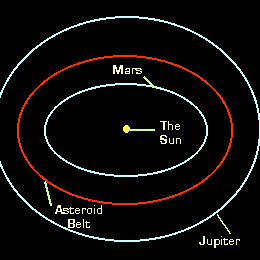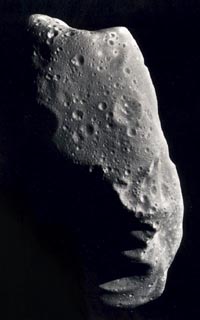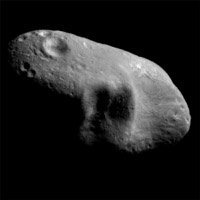
![]() Main Page
Main Page
![]() Feedback
Feedback
 The Author
The Author
 News
News
 Search
Search
 The Planets
The Planets
 Mercury
Mercury
 Venus
Venus
 Earth
Earth
 Mars
Mars
 Jupiter
Jupiter
 Saturn
Saturn
 Uranus
Uranus
 Neptune
Neptune
 Pluto
Pluto
 Dwarf Planets
Dwarf Planets
 The Solar System
The Solar System
 The Sun
The Sun
 The Moon
The Moon
 Meteors
Meteors
 Comets
Comets
 Asteroids
Asteroids
 Amazing facts
Amazing facts
 Other
Resources
Other
Resources
 Poster Store
Poster Store
 Multimedia
Multimedia
 Links
Links
 Awards
Awards
 Glossary
Glossary
 Astronomers
Astronomers
 Webrings
Webrings
 Bibliography
Bibliography
Asteroids
More Images of Asteroids Here |
Print this information out Here |
|||||||||||||
|
The name 'Asteroid' was given by Sir William Herschel in 1802, shortly after they were discovered. It means 'like a star' in Greek. What is an Asteroid? The largest discovered asteroid is 'Ceres', though it has subsequently been reclassified as a Dwarf planet, which is a massive 940km in diameter, and was discovered in 1801 by Italian astronomer Giuseppe Piazzi (Ceres was in fact also the first asteroid to be discovered, and the first, and so far only, to be recategorised as a Dwarf Planet). 92.8% of all the asteroids so far examined are found to be made of rock whilst 5.7% are made from a mixture of Nickel and Iron. Their shapes tend to be highly irregular, as they do not have strong enough gravitational fields to pull them into a sphere, and some asteroids have been found to have their own 'moons'. Asteroid Locations and Dangers Most asteroids in the Solar System are to be found in the Asteroid Belt (or Main Belt) which is in an elliptical orbit
However, small bodies such as asteroids don't all just stay put in a regular orbit all the time. In fact, some can be found inside the Earth's own orbit. All it takes is for one asteroid to hit another for them both to end up hurtling away at high speed into the rest of the Solar Sysyem. Obviously this presents a potentially dangerous situation if a sizeable asteroid happens to end up hitting Earth. There is even a theory, which has recieved a lot of support in recent years, which suggests that the dinosaurs were wiped out when an asteroid or comet hit the Earth near the Yucatan peninsula, forming the Chicxulub Crater, although this is in no way known for sure. Nevertheless, the potential for damage is catastrophic for humans, if an asteroid of a kilometre were to collide with the Earth, and it is primarily for this reason that both public curiosity and scientific research on asteroids have been increasing substantially in recent decades. Origin of Asteroids There are many theories as to how asteroids originated but the most likely one is that they are left-overs from when the Solar System was created. Originally, there may have been as many as eight Mars sized objects in the main belt, but if this were the case, Jupiter's gravitational influence would have slowly caused them to fragment, which would explain the asteroid belt as we see it today. One of these 'Mars-like' objects probably crashed into the young Earth creating the moon (this is known as the 'Big Splash', see the Earth section for more details), another one must have survived and is now called Mars and the rest got broken up in collisions, with most of the debris now scattered around the Solar System or burned in the Sun and the rest in the Asteroid Belt.
The NEAR Mission The NEAR (Near Earth Asteroid Rendezvous) spacecraft was launched in 1996 too examine a certain asteroid called Eros (which is not actually part of the Main Belt) and on its way, it passed just 1,200 km away from asteroid Matilde. The NEAR mission was very fruitful, and it revealed a lot of useful information about Eros, before it crashed, as planned, into the asteroid itself, taking photos from as close as 130 metres above the surface of Eros. For many fascinating pictures of this asteroid, including some as close as a few miles, go to the NEAR website. |
||||||||||||||
Asteroids Links |
||||||||||||||
|
||||||||||||||
 Sometimes referred to as as 'minor planets', asteroids are small fragments of rock,
not large enough to be classified as Planets or Dwarf Planets, left over from the formation of the Solar System
about 4,500 million years ago. Over 8,000 of these have now been
catalogued, though it is thought that vastly more lie undiscovered.
Those catalogued range wildly in size from the odd metre to hundreds of
kilometres wide, although only about 250 have diameters of over 100km, and most tend to be
about 1km across.
Sometimes referred to as as 'minor planets', asteroids are small fragments of rock,
not large enough to be classified as Planets or Dwarf Planets, left over from the formation of the Solar System
about 4,500 million years ago. Over 8,000 of these have now been
catalogued, though it is thought that vastly more lie undiscovered.
Those catalogued range wildly in size from the odd metre to hundreds of
kilometres wide, although only about 250 have diameters of over 100km, and most tend to be
about 1km across.

